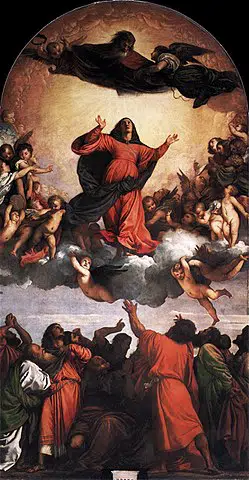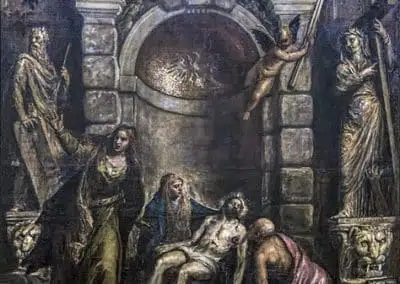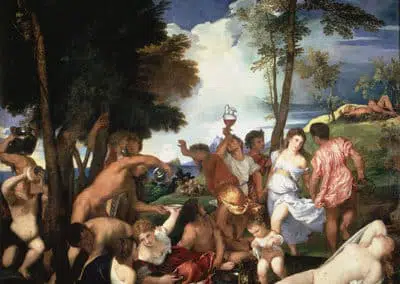
Titian (Tiziano Vecellio) – Pieve di Cadore 1490ca, Venice 1576
Titian, a very precocious artist, arrived very young in Venice from the town of Pieve di Cadore located at the eastern Dolomite mountains. He had as masters Giovanni Bellini and Giorgione, with whom in 1508 he collaborated in the decoration of the Fondaco dei Tedeschi. The first works of Titian show an evident suggestion of Giorgione’s painting. In 1511, in the town of Padua, he frescoed the “Miracles of Saint Anthony” in the Scuola del Santo, where to a Giorgionesque vein he combines a marked narrative character. Around 1515 he accomplishes the painting known as the “Sacred and Profane Love“, kept at the Galleria Borghese in Rome, one of the master’s most famous and enigmatic works.
Titian and Venice
Considered one of the most important Venetian artists, after Giorgione’s death, Titian became the most famous painter in Venice. In 1516 the Venetian painter received the prestigious commission for the altarpiece of the “Assumption of the Virgin“, completed in 1518 and placed on the main altar of the Frari church in Venice. In the years that followed, thanks to the success acquired by his scenographic and monumental painting, Titian obtains the commission for several other altarpieces. Between 1519 and 1526 he painted the “Pesaro Madonna” for the chapel of the homonymous family always in the church of Santa Maria dei Frari. While between 1520 and 1522 he completed the “Averoldi Polyptych” for the church of Santi Nazzaro and Celso in Brescia.
The fame of the artist
After the death of Giovanni Bellini (1516), he was designated official painter of the Serenissima. In the Doge’s Palace of Venice, Titian performs many works of which very few will survive after the devastating fire of 1567. Well-known artist, he is required by the courts of Ferrara, Mantua, and Urbino. For Alfonso I d’Este he paints the three “Bacchanals”, now divided between the Museo del Prado in Madrid and the National Gallery of London. For Guidobaldo II della Rovere, in 1538, he painted the so-called “Venus of Urbino“, today at the Uffizi Gallery in Florence. This is the century where other 2 important venetian painters worked in the town: Tintoretto and Paolo Veronese
Portrait painter
His portrait painting skill makes him the favorite painter of Charles V and Philip II, of whom he performs numerous portraits. After the invitation of Charles V, he went twice to Augsburg, where he received the important commendation of the Empire Count Palatine. In 1545 he went to Rome, where he realized the portrait of Pope Paul III with his nephews Ottavio and Alessandro Farnese (Naples, Museum of Capodimonte) and he painted for Ottavio Farnese the “Danae” (1546, Naples, Museum of Capodimonte).
His stay in Rome
The works of the Roman stay demonstrate a renewed interest in color and light. His painting is now characterized by warm and sumptuous colors that the light makes vibrate with sudden flares. The late activity of his long career includes works such as the “Annunciation” of the church of San Salvatore in Venice, the “Christ Crowned with Thorns” at the Alte Pinakothek in Munich and the unfinished “Pietà” of the Gallerie dell’Accademia in Venice.
















